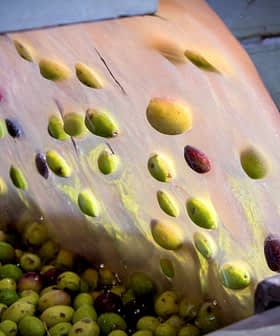Olive Oil Industry Megatrends
The global olive industry is influenced by various factors, including globalization, competition from other vegetable oils, and the shift towards high-density groves and mechanization. The industry is also facing challenges related to quality, certification, and consumer confusion, which can be addressed through online sales and a focus on promoting the positive attributes of olive oil. Ultimately, the industry must adapt to these megatrends to sustain and grow olive oil enterprises of all sizes.

The global olive industry is a complex matrix of production, distribution and consumer behaviour which changes daily with climatic conditions, political activity and the decisions of businesses, large and small. The industry does not operate in isolation, it is affected by the trends in competing vegetable oil industries, the global financial situation, social imperatives and the emergence of new technology. Olive oil consumption has a very long history and an assured future. The future will be shaped by the global industry’s recognition and strategic response to the many challenges it will face. An important step in responding effectively at local, regional and international levels is the recognition of the most important trends which will influence the industry over the next ten years. The following ‘megatrends’ are identified as the most significant factors which should be considered when planning to sustain and grow all small, medium and large olive oil enterprises.
Globalisation
Historically the olive industry has been concentrated in, and controlled by, Mediterranean countries. Over the past two decades there has been an expansion of the production base to countries which previously were net importers, namely the USA, Australia, Chile and more recently China and India. While production in these countries is less than 2% of world production, their presence has had an impact on the global politics of olive oil as the new entrants strive to displace imports with domestic products and expand into the export market.
Traditional producing countries, especially Spain, have expanded their production base into neighbouring countries such as Portugal and Morocco, as well as establishing joint ventures in South America, China and India.
The aggressive growth of the industry in Spain has resulted in the acquisition of brands which traditionally were associated with Italy. This trend has resulted in a blurring of the association of brands with particular producing countries and seen the growth of large corporations operating without the constraints of borders.
The recent political activity in the European Union is evidence that olive oil has become a political tool and the regional interests in Europe will be superseded by legislation which favours those that have the lobbying power to further their own interests. Inevitably this will lead to laws which favour the larger more concentrated enterprises at the expense of smaller local and regional producers. The recent enactment and withdrawal of regulations controlling the presentation of olive oil on restaurant tables in non-refillable branded bottles is a prime example of this.
Another aspect of the globalisation is the spread of varieties from specific regions across new regions and countries. Koroneiki which is the backbone of the Greek olive oil production is now produced in at least Spain and Australia, Italian varieties are grown in Spain, Chile and the USA. This will mean that those countries that have a range of varieties will be able to mimic and market styles of olive oil which will compete with those hitherto described as ‘Italian’, ‘Greek’ or ‘Spanish’.
Worldwide, the aggregation of large production and export olive oil enterprises has widened the gap between local small producers and these conglomerates. This has resulted in small to medium producers forming associations to promote high quality extra virgin olive oil, an example is the recently-launched Spanish Extra Virgin Olive Oil Association involving 150 to 200 Spanish mills.
Another predictable trend is the acquisition by European producers of larger enterprises in the Southern Hemisphere to neutralise competition in the region and to acquire production that will provide fresh extra virgin olive oil for sale and blending six months after the Northern Hemisphere production.
High density groves and mechanisation
A megatrend in production is the establishment of medium- to high-density groves with mechanised harvesting. Many Mediterranean countries which traditionally relied on the supply of olives from small groves aggregated into cooperatives are increasingly getting the bulk of their olives from new high-density groves. This is placing considerable pressure on the more labour-intensive small production, and causing associated social problems in countries such as Spain, Italy and Greece. These countries already have very high unemployment and are faced with many small producers losing their traditional income and joining the unemployed.
This trend is affecting the policy on the gradual removal of subsidies for olive oil production. European governments are faced with the dilemma of either continuing with subsidies and keeping workers in the groves, or removing subsidies and increasing the number of unemployed in rural areas. For this reason it can be expected that removal of subsidies will be resisted and slowed down.
A positive result of the intensification and mechanisation is the reduced production cost which will keep olive oil relatively competitive with other vegetable oils such as rice bran, canola/rapeseed, soya, corn and peanut oils which are produced on a broadacre scale.
Competition from vegetable oils
The International Olive Council’s recent assessment that world production in 2013 has dropped by 26% with consumption falling by 5% opens the markets to increased sales from competing vegetable oils. The price of extra virgin olive oil in Spain has risen to €2.74 from a low of €1.77. The combination of reduced production and higher prices will put further pressure on the retention of market share.
An analysis by the North American Olive Oil Association (NAOOA) presented to the Savantes programme in New York in September, 2012 showed that, despite the low price and abundant supply of olive oil in the previous year in the USA, and a decline of 20.8% in vegetable oils including corn, canola and peanut oils, olive oil sales increased by 5.1% while other oils increased by 31.8%. This inability to take advantage of a shortage of competing vegetable oils loss should be a warning to the olive oil industry that there needs to be a concerted effort to retain and increase market share.
This is reinforced by updated data from the USDA which shows that olive oil produced globally continues to decline as a percentage of total vegetable oil. In six years since 2007 the percentage has dropped from 2.4% to 2.0%
One of the major characteristics of extra virgin olive oil that makes it vulnerable to promotion of competing oils is smoke point. While high quality extra virgin olive oil has a smoke point of around 405ºF (191ºC), refined olive oil has a higher smoke point of around 465ºF (242ºC). The latter provides the olive industry with the means of competing with vegetable oils with higher smoke point, and at the same time promoting extra virgin olive oil as ideal for lower temperature cooking. If consumers can be persuaded to use different classifications of olive oil for all cooking they are less likely to turn to other vegetable oils with fewer health benefits.
In an attempt to neutralise the advantage that olive oil has in its well-documented health benefits, producers of competing oils are using genetic engineering and new processing techniques, such as cold pressing, to mimic the chemical profile and taste of olive oil. Examples of this are high-oleic-acid canola oil, cold-pressed canola oil and cold-pressed avocado oil. The increased production in South America of avocado oil with its high smoke point, comparable fatty acid profile and lower price should be seen as a real threat to the olive oil market in the USA.
Having set the standard for high quality vegetable oils, olive oil must defend its position more effectively. One differentiation that is difficult to mimic is taste. However, a recent UC Davis Consumer Survey showed that in the USA, the world’s largest importer outside the EU, “consumers did not agree that words often used to describe fresh olive oil sounded tasty (fruity, peppery. and grassy).” A coordinated and concerted effort to ‘sell’ the taste of extra virgin olive oil is required.
One opportunity that will help maintain the margins for extra virgin olive oil as the price differential between olive oil and vegetable oils increases, is to use it as a high value component of vegetable oil blends for foodservice. This will add flavor and health components to the blend, amortise the higher cost and take advantage of the imperative for higher smoke points in commercial kitchens.
Increased proportion of extra virgin produced
There is evidence that a greater proportion of extra virgin olive oil is being produced in the Mediterranean countries. This is a consequence of improved production techniques and pursuit of higher returns.
In countries such as Greece, Turkey, Tunisia, and Morocco, producers that have generally supplied into bulk markets are now shifting to bottled branded products. This will both increase the competition for retail shelf-space and deprive countries such as Italy who have purchased bulk undifferentiated extra virgin olive oil to blend with their higher grade production. The aggressive brand marketing undertaken by Spain, which has been the largest supplier of bulk oils to Italy, will further exacerbate this shortage of bulk oil.
The shift to more proprietary brands of extra virgin olive is occurring while the large supermarket chains are introducing more ‘house’ and ‘private label’ brands and reducing the number of proprietary brands on their shelves. Supermarkets which move up to 80% of the world’s packaged olive oil can exercise their market power to obtain olive oil at reduced prices and impose greater control over the quality specifications of the oil bottled in their private labels products.
The ascendancy of supermarket brands will favour the largest producers who can supply large volumes at low prices and meet the stringent quality assurance specifications imposed by buyers. This will increase the pressure on the burgeoning extra virgin olive oil brands and further contribute to the concentration of power by the conglomerates. A concentration which will force medium size producers to aggregate their marketing effort or concentrate on the smaller volume of olive oil products moved through local markets, specialty stores and high end foodservice.
Quality in the forefront
The entry of new producing countries from the Southern Hemisphere and the increase in branded bottled extra virgin olive oil has increased the importance of quality and certification.
The International Olive Council has had primacy in the setting of olive oil classification standards and the policing of compliance. The EU has taken an increasing role in assuring compliance and new producing countries, especially Australia, have become very active in exposing non-compliance.
The activity of Australian, New Zealand, South African and USA associations has brought a new dimension to the public exposure of adulteration and the deterioration of olive oil. Under the thin guise of improving quality for consumers and timed with the publication of the book ‘Extra Virginity: The Sublime and Scandalous World of Olive Oil’ these countries have strategically used the testing of products, especially imports, as a marketing tool to sell local fresher extra virgin olive oil. At the same time the development of the ‘Australian Standard’ has attempted to increase the tolerance levels of markers such as campesterol to accommodate the higher levels exhibited by new varieties and variations under different growing conditions.
Associated with this new standard has been the push to include two new tests, pyropheophytin (PPP) and 1,2‑diacylglycerol (DAGs) which it is claimed detect deterioration and adulteration with more accuracy and objectivity than the subjective panel ‘organoleptic’ taste testing. Some European producers have advocated more stringent application of existing specifications. All this activity has forced the IOC to launch an international research project on olive oil authentication with the aid of EU Horizon2020 funding.
Along with the classification specifications, labelling has been under increased scrutiny. Descriptions such as ‘lite’, ‘extra light’ and ‘pure’ olive oil, which have been used to market refined oils and blends, will be replaced with the more prosaic description ‘refined’ if the advocates are successful. This move is intended to put refined olive oil at a disadvantage with extra virgin olive oil, but may at the same time put refined olive oil at disadvantage with other vegetable oils which are not only refined, but also solvent extracted. The denigration of refined olive oil will also remove a product used by those who either do not like the taste of, or cannot afford, the higher priced extra virgin olive oil.
The argument that those who dislike the intense flavors of extra virgin olive oil can use the more delicate oils is undermined if the PPP test is adopted internationally. The test will favour more robust oils high in polyphenols which have longer shelf-life and are less likely to become rancid during overseas shipment.
The courts are increasingly being used to pursue commercial interests against competing brands, and conversely by commercial interests to challenge consumer publication of reports on retail brands. In Spain, Hojiblanca, ArteOliva and Acesur threatened to sue the Organization of Consumers and Users for not observing proper practice in testing their brands (Olive Oil Times June 23rd , 2013). The North American Olive Oil Association (NAOOA) is pursuing a brand in the courts for misleading consumers. Following adverse reports from UC Davis on the quality of some olive oil brands retailed in California, a law firm launched then dropped a class action against retailers when the chemical and taste testing in the report could not be duplicated. In Australia there have been numerous actions by the Australian Competition and Consumer Commission against mislabelled olive oil products.
Many established participants in the industry have commented that all this publicity given to legal interaction and non-compliance has adversely affected consumer perception of the integrity of olive oil. The UC Davis report on ‘Consumer Attitudes on Olive Oil’ published in May 2013 has confirmed that consumers are confused or have poor knowledge of the classifications of olive oil and the descriptions used for taste.
The giant olive oil company Deoleo has stated that ‘current terms such as ‘extra virgin, ‘virgin’ and ‘refined’ olive oil should be replaced with words meaning more to consumers.’ (Olive Oil Times May 6th 2013). The USA court dealing with the NAOOA case found that there is ‘no extrinsic evidence that the perceptions of ordinary consumers align with these various (olive oil) labelling standards‘.
There has also been push back against the attempts by the domestic producers to include in the Farm Bill clauses paving the way for a market order to be introduced in the USA. The move was overwhelmingly defeated in the House of Representatives (Olive Oil Times June 23rd, 2013). The international Olive Council has also flagged that there could be a challenge, through The World Trade Organisation, to any attempt by importing countries such as Australia to introduce standards which could be barriers to trade.
This consumer confusion can only be exacerbated by increasing layers of certification and the introduction of even more classifications, such as ultra premium, by enterprises that are striving to increase market share.
Competing vegetable oils such as rice bran and cold pressed canola are increasing promotion to take advantage of this fragmentation of the international control of olive oil quality, associated bad publicity and the worldwide shortage of olive oil.
The internecine legal activity and denigration of competing brands can only contribute to further consumer confusion and loss of confidence in olive oil. Perceptively fewer media articles and reports on non-compliance in 2013 is evidence that the very public and indulgent pursuit of commercial advantage by new olive oil brands is on the wane and the international industry is moving back to more centralised control of quality and generic promotion of olive oil. This in time will divert energy and money from internal conflict to a concerted effort to once again establish olive oil as the leading, most healthy and tastiest vegetable oil.
Online for sales and news
The internet has revolutionised communication and enabled more direct interaction with the consumer, by-passing the institutions which have in the past controlled the flow of information.
The strategic use of the internet has facilitated the campaign on compliance conducted by associations, academic institutions and analytical laboratories. The campaign has given prominence to new producing countries which are not members of the International Olive Council and therefore not bound by its protocols. The campaign has been successful in its perceived aim of highlighting non-compliance, especially of imported brands, promoting new procedures for authentication, displacing imported brands with local production and raising the debate on fraud in the olive industry.
This online tactic will play out and the initiative of the IOC in tackling the authentication and compliance issues will go some way to neutralise the public disquiet over the authenticity and quality of olive oil. The internet can then be used to gain market share by promoting the positive attributes of olive oil.
The internet will be increasingly used to sell direct to consumers, breaking the stranglehold of established distribution channels. This will come about with the increasing availability of applications for smartphones which can read barcodes and QR-codes giving the consumer direct access to quality information, price comparison and online purchasing.
The breakdown of the many stages of the established supply-chain will give consumers direct access to authentic fresher extra virgin olive oil and the resulting move away from distribution and retail focal points will make the task of regulators in policing standards more difficult.
Online sales will also have an impact on the burgeoning boutique olive oil stores in new producing countries such as the USA unless they adapt effectively to this new sales paradigm.
Summary of megatrends
To summarise, the megatrends which will dictate the business decisions of all involved in the olive oil industry, from production to retail, are:
- Increased globalisation blurring the regional advantages of olive oil production and resulting in the concentration in power and market share.
- Widening of the gap between small and medium enterprises and international olive oil conglomerates.
- Increased production efficiency and mechanisation in larger groves marginalising traditional production and again increasing the gap between small and medium producers and conglomerates.
- Increased competition for the vegetable oil global market from genetically modified oilseeds, new crops such as avocado oil and new processing techniques such as cold pressing of oilseeds.
- The proportion of extra virgin olive oil produced will continue to increase at the expense of refined olive oil. This will increase competition for retail shelf space for branded products and tend to put downward pressure on extra virgin olive prices.
- Quality and price will continue to be the main differentiations for extra virgin olive oil.
- The wave of public prosecutions and publicity over non-compliant oils will decline as the International Olive Council reasserts its leadership in eliminating fraud, new producing countries gain adequate market share and the global industry switches to promotion of the positive attributes of olive oil.
- Online sales will increase and consumers will have available applications for smart phones to scan barcodes and QR-codes to determine the quality, health profile, authenticity and comparative value of extra virgin olive oil brands.
- Direct sales online from producers to consumers will shorten the supply-chain and make it more difficult for regulators to police quality and labelling standards with the more dispersed retail marketplace.









